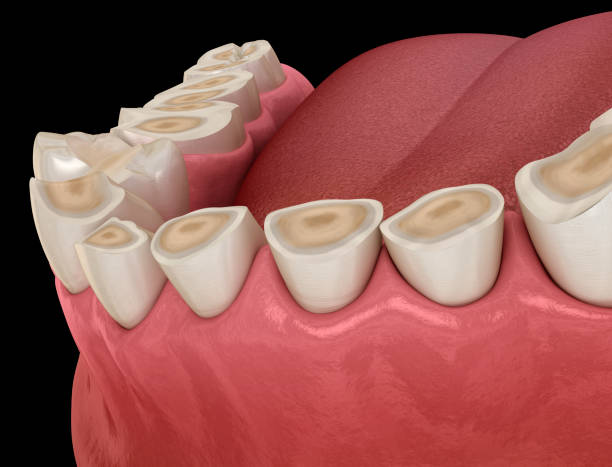Last Updated on: 5th August 2024, 06:19 am
Cavities from grinding teeth
Bruxism can cause headaches, earaches, facial pain, and also chewing, malocclusions, and pathologies of the temporomandibular joint (DTM). Continuous teeth grinding can also lead to loss of tooth enamel and make teeth more susceptible to tooth decay. Those who suffer from bruxism will often report joint and tooth pain, particularly in the area of the posterior molars.
Cervical cavities are varied in shape, size, and texture: flat, cusp, and wedge-shaped, polished or striated. Gum recession is part of the event.

Davies S. et al. (2002) call NCCL the loss of the tooth surface not caused by caries or trauma, which can be physiological or pathological in nature. The loss of dental tissue is pathological when there is a change in the appearance of the tooth. The presence of pain or sensitivity, loss of vertical dimension or posterior occlusal stability implies an increase in tooth wear with facets and a failure of dental restorations. There is hypermobility and deviation of dental position.
The Glossary of Prosthodontic Terms definition mentions that abfraction is the pathological loss of tooth substance caused by biomechanical forces that are far from the load point on the tooth, which cause flexion, chemical fatigue, and degradation of the enamel with dentin. In the restorative approach to teeth with NCCL, whether with resin or if the coronal involvement with a metal-ceramic crown and its occlusal adjustment in working laterality is pervasive, the lesion continues its course and appears apical of the restoration.
Tooth wear is caused by three phenomena: erosion, attrition, and abrasion
- Erosion: it is the progressive loss of tooth surface due to chemical or acid dissolution; there are no bacteria involved. Erosion of tooth enamel is mainly the result of too frequent or inappropriate use of carbonated drinks and fruit juices with high levels of acidity. Erosion is also a problem in people who suffer from GERD due to certain eating disorders, such as anorexia or bulimia.
- Attrition: is the progressive loss of the hard surface of the teeth caused by chewing or grinding against opposing or antagonistic teeth. The degree of wear will depend on the use that each person makes of their teeth. For example, it will increase in people who suffer from bruxism or in people who have a particularly fibrous diet.
- Abrasion: is the progressive loss of tooth enamel caused by mechanical actions other than chewing or contact between teeth. Abrasion is commonly associated with improper tooth brushing techniques, resulting in gouges at the junction of the crown and root of the teeth. It will also be seen in people who use their teeth as a tool to remove bottle caps, or hold pins, clips, or nails.
Palamara J. et al. (2006) report that the etiology of NCCL is a combined effect of abrasion from brushing, erosion, corrosion, and the concentration of forces that produce flexion in teeth during chewing.
The frequent site of location of the lesions is on the frontal face. It is less common on the inside of the molars of the jaw and can be explained by the protective role of the serous saliva film. The word dental abfraction is a mechanical micro fracture of the tooth structure in or without a corrosive substance. The wedge shape of the lesion indicates the occlusal force on the tooth as the causal relationship, due to occlusal disharmonies, parafunction, and the psychological stress of the patient. The absence of wear facets of the occlusal enamel indicates few cervical lesions.

The problem of non-carious cervical dental injury increases with age 45 years and older and is explained as fragility of the enamel with aging. Tugnait A. et al. (2001) mention that the migration of the gingiva towards the dental neck or the apical location of the marginal gingiva towards the apical of the dentin enamel junction increases with age, many factors play a role in the etiology, such as occlusion trauma and periodontal disease. The response to this event is pain with exposed root and coronal dentin, root caries, and loss of dental and gingival aesthetics.
Peumans M. et al. (2007) mention that flexion in the neck of the teeth has been one of the three factors that cause NCCL. Repetitive forces of tension and compression disrupt hydroxyapatite crystals, making them more susceptible to mechanical (brushing) and chemical degradation (acidic: food or drink).
How to prevent Tooth Wear
- The main prevention measures include reducing the frequency of consumption of carbonated beverages and fruit juices with high levels of acidity.
- Tooth brushing should be avoided immediately after consuming acidic foods and beverages, as acid softens enamel and makes it susceptible to brushing damage. In turn, it is advisable to use low abrasive toothpaste if we are prone to tooth wear.
- In the case of bruxism, treatment usually requires the use of a shock splint during sleep.
- Abrasion can be reduced by adopting the correct brushing technique. Also, the teeth should not be used as a tool to grasp or hold objects.

Finally, as a preventive measure, it is advisable to visit the dentist for a check-up every six months. In this way, you will be able to detect dental wear in time and we will offer you the necessary advice and/or treatments for each particular case
Therapeutics in the currente context
The subject of non-carious cervical dental lesions (NCCL) or dental abfraction has been questioned by different authors to approach the study of the subject. Although, according to each person, the possible etiology is varied. The truth is that it is necessary to resolve not only the uncertainty but also the clinical solution of the event. It confronts the treating dentist with the panorama of discernment of logic.

Guevara Gómez SA et al., recommend that the precise diagnosis and type of expression (clenching or grinding), in addition to the restoration of the damage, the professional should be able to better counteract the origins if interdisciplinary management is carried out and institutes relaxing and muscle reprogramming procedures, through appliances, physiotherapy, massages, exercises, relaxation and imagination therapy. Díaz Rebolledo et al. allude that the treatment of this disease will depend on the time of the establishment of the habit and the wear caused, these two factors can be reversible (control of the contributing factors, drugs, and splints) and irreversible (occlusal adjustment and oral rehabilitation).
In the framework of modern restorative stomatology, Montero Parrilla JM, et al, executes the occlusal-articular rehabilitation of the bruxoman patient as a therapeutic procedure, with a Fixed Partial prosthesis (construction of a fixed acrylic-coated chrome-nickel bridge) and a myorelaxant occlusal acrylic splint to restore the occlusive vertical dimension. García Aguacil C de los M, et al. ventures into metallic overdenture and refers to restore architectural, functional, and aesthetic recovery to the treated patient. More conservative is the proposal by Pontons Melo JC, et al., where before the pathological dental wear of the anterior guide by bruxism undertakes aesthetic and functional restoration, a layering technique with composite resins is used.
Contact Us: Cavities From Grinding Teeth
Of this pathology, it can be said that complications and prognosis are often aggravated by the variety of characteristics of each patient as well as the coping with this disease. It is, therefore, necessary not to ignore distressing situations that could lead to developing difficult emotional tensions to control. Patients are recommended to promptly see a professional who can guide them in this and other aspects of bruxism.
If you have any questions about this or other topics, you can contact us at Channel Islands Family Dental, as well as on our Facebook page. At Channel Islands Family Dental, we will be attentive to your visit to make a timely diagnosis. Besides, our dentists in Oxnard, Santa Paula, Ventura, and Port Hueneme will be able to guide you to the best treatment to give you back your best smile.



